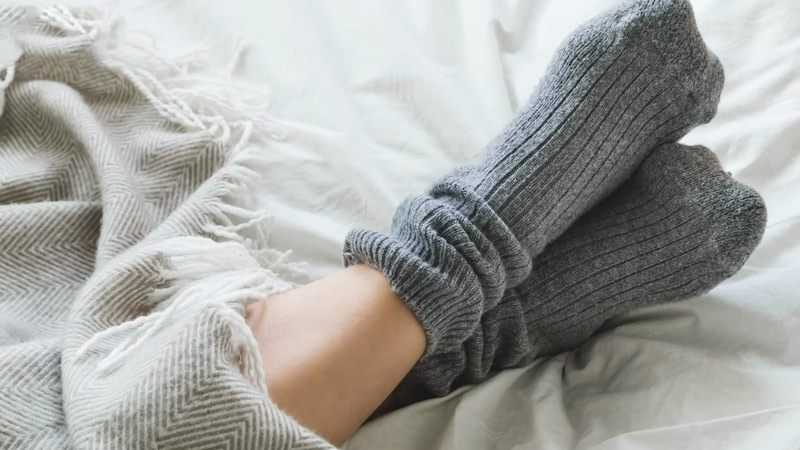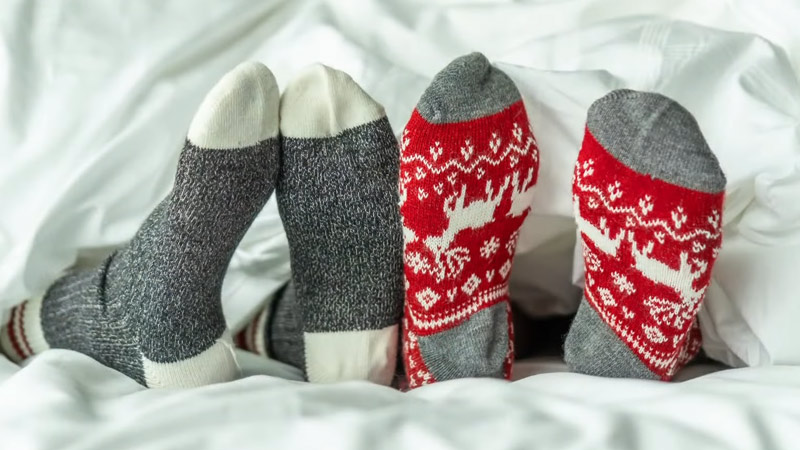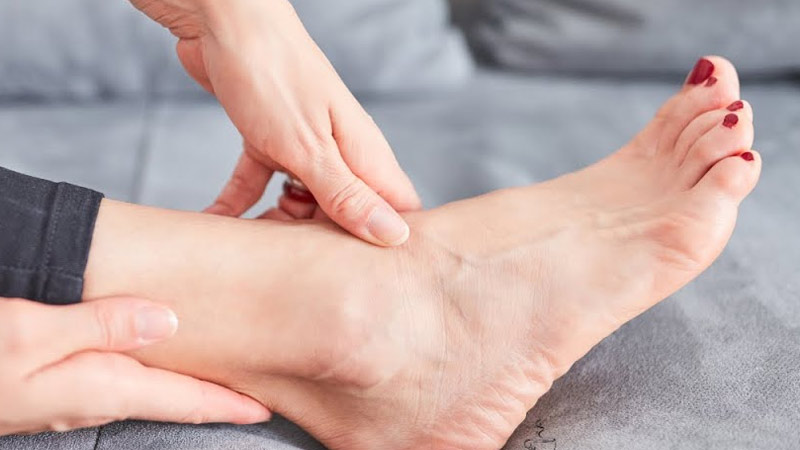Many people experience the peculiar phenomenon of feeling colder when wearing socks. This counterintuitive experience can leave individuals scratching their heads and wondering why their trusty socks seem to betray them, failing to provide the expected warmth.
In this article, we will explore the various factors that can lead to this sensation and delve into the science behind why socks make your feet feel colder in certain situations.

Why Do Socks Make My Feet Colder?
The seemingly contradictory phenomenon of feeling colder while wearing socks has puzzled many individuals.
Here are the most exact reasons why socks make your feet colder:
Role of Insulation and Temperature Regulation
Socks, as well as other clothing items, work by trapping a layer of air next to the skin. This layer of air acts as insulation, preventing heat loss from the body to the surroundings. The insulating effect of socks is especially crucial for our feet since they are farthest from our body’s core and therefore more susceptible to temperature changes.
Properly insulating socks can help retain the natural heat generated by our feet and maintain a comfortable temperature. However, when the surrounding environment becomes colder or more humid, the insulating capabilities of socks might not be sufficient, leading to a sensation of cold feet.
Inadequate Material or Thickness
One of the primary reasons socks may contribute to colder feet is the choice of material and thickness. The type of fabric used in the construction of socks plays a significant role in their insulating properties.
Natural fibers like wool and cotton are often used for their warmth-retaining characteristics, while synthetic materials like polyester can have a more insulating effect.
If you find your feet feeling colder with certain socks, it might be worth examining the material and thickness of the socks you’re wearing. Thinner socks or those made from materials with poor insulating properties may not effectively trap heat, leading to a sensation of cold feet.
Moisture Management
Moisture management is another crucial aspect to consider when examining why socks can sometimes make feet colder. Our feet naturally perspire throughout the day, and when trapped within socks, this moisture can accumulate.

If socks are unable to wick away moisture efficiently, the dampness can reduce their insulating properties, making feet feel colder.
Quality socks with moisture-wicking properties can help keep feet dry and comfortable, preventing the accumulation of sweat that can contribute to cold feet.
On the other hand, poor-quality socks with inadequate moisture management can leave feet feeling damp and chilled.
Constriction of Blood Flow
Wearing tight or ill-fitting socks can also contribute to the sensation of cold feet. When socks are too tight, they can restrict blood flow to the feet, reducing the amount of warm blood reaching the extremities. As a result, your feet may feel colder, even if the socks are of good quality and properly insulating.
To prevent this issue, it’s essential to choose socks that fit well and allow proper circulation. Socks with too-tight elastic bands or those that are too small for your feet can constrict blood flow and contribute to the feeling of coldness.
Poor Circulation and Medical Conditions

In some cases, the sensation of cold feet while wearing socks could be a symptom of an underlying medical condition or poor circulation.
Conditions like Raynaud’s disease, peripheral artery disease, or diabetes can affect blood flow to the extremities, leading to cold feet even when wearing socks. If you consistently experience cold feet with socks on, it’s crucial to consult a healthcare professional to rule out any underlying health issues.
Environmental Factors
Apart from the socks themselves, various environmental factors can contribute to the feeling of cold feet. For instance, walking on cold surfaces like tiled floors or concrete can quickly draw heat away from the feet, even when wearing socks.
Additionally, exposure to cold air or spending extended periods outdoors in low temperatures can overwhelm the insulating capabilities of socks.
In these situations, wearing thicker socks or layering them can help mitigate the coldness and improve insulation. Furthermore, pairing socks with appropriate footwear, like insulated boots, can enhance their overall effectiveness in keeping your feet warm.
Body Temperature Regulation and Cold Extremities
Individual differences in body temperature regulation can also explain why some people experience cold feet more frequently than others, even with socks on.
Our bodies naturally prioritize the core temperature, which means they might reduce blood flow to the extremities, including the feet, when exposed to cold environments. This protective mechanism helps maintain the internal organs’ warmth but leaves the feet feeling cold.
Moreover, factors like age, metabolism, and physical activity level can also influence how our bodies regulate temperature. Individuals with a slower metabolism or reduced physical activity might be more prone to experiencing cold feet.
Tips to Keep Your Feet Warm
Keeping your feet warm is essential for overall comfort and well-being, especially during colder weather.
Here are some tips to help you maintain cozy and warm feet:
Wear Insulated Socks
Insulated socks are a crucial investment for keeping your feet warm in cold weather. Natural fibers like wool and thermal fabrics have excellent insulating properties, creating a layer of warmth around your feet.
These socks are available in various thicknesses, making them suitable for different weather conditions. In extremely cold environments, consider wearing thicker woolen socks for maximum insulation.
Layering
Layering socks is a simple yet effective way to enhance foot warmth. When the temperature drops significantly, consider wearing two pairs of socks. Start with a thin, moisture-wicking sock close to the skin to keep your feet dry, and then add a thicker, insulating sock on top.
The air trapped between the layers acts as additional insulation, preventing heat loss. Just ensure that the socks are not too tight when layering to maintain proper blood circulation.
Use Moisture-Wicking Socks
Moisture-wicking socks are designed to pull sweat away from your feet, keeping them dry and comfortable. Dampness can lead to a feeling of coldness, even in insulated socks.
Moisture-wicking materials, such as synthetic blends or specially treated natural fibers, prevent sweat buildup and help maintain a cozy environment for your feet. These socks are particularly useful for activities that cause your feet to perspire, like sports or hiking.
Proper Footwear
The right footwear is essential for keeping your feet warm and protected from the cold. Choose shoes or boots that offer insulation and are suitable for the specific weather conditions you’ll be facing. Look for footwear with thermal linings, such as fleece or fur, which provide extra warmth.
Additionally, consider shoes or boots with a waterproof outer layer to keep your feet dry in wet or snowy conditions. The fit should be snug but not too tight, allowing proper blood circulation.
Warm Insoles
Thermal or heated insoles are an excellent addition to your footwear, especially during colder days. These insoles contain heating elements that generate warmth when powered.
You can find both disposable and rechargeable options. Place them inside your shoes or boots before going out, and they will help maintain comfortable foot temperature throughout your outdoor activities.
Avoid Tight Footwear
Wearing tight shoes or boots can restrict blood flow to your feet, leading to coldness. To ensure proper circulation and warmth, choose footwear with enough room for your toes to move comfortably.
Avoid cramming your feet into too-small shoes, as this can also cause discomfort and decrease insulation.
Warm Up Before Venturing Out
Before stepping outside in chilly weather, take a few minutes to warm up your feet. Engage in some light exercise, like walking or jumping in place, to improve blood circulation to your extremities.
You can also use a heating pad or warm compress to gently warm your feet before putting on your shoes or boots. By pre-warming your feet, you reduce the shock of exposure to the cold and improve their ability to stay warm.
Keep Feet Dry
Wet feet are more susceptible to feeling cold due to rapid heat loss. If your feet get wet, either due to rain, snow, or perspiration, change into dry socks and footwear as soon as possible.
Carry an extra pair of socks with you during outdoor activities to ensure you can keep your feet dry when needed.
Use Foot Warmers
Disposable foot warmers can provide instant warmth during outdoor activities in cold weather. They are readily available and can be slipped into your socks or shoes.
Warm Baths
Soak your feet in warm water to improve blood flow and provide temporary relief from cold feet. Avoid hot water, as it can damage your skin and exacerbate the problem.
Stay Active
Physical activity helps improve blood circulation, which can keep your feet warm. Regular movement and exercise can also promote overall warmth in the body.
Wear Warm Slippers
While indoors, wear warm and cozy slippers with soft, insulated linings to keep your feet comfortable. During colder months, cold floors can lead to discomfort, and warm slippers offer a quick solution to keep your feet snug and warm.
Warm Bedding
Ensure your feet stay warm while sleeping by using blankets or electric blankets. Cold feet can interfere with your ability to fall asleep and reduce overall comfort during the night. By keeping your feet covered and warm, you’ll promote better sleep and wake up feeling refreshed.
FAQs
Can wearing socks that are too loose make my feet feel colder?
Yes, wearing socks that are too loose can indeed contribute to colder feet. Loose-fitting socks may allow cold air to circulate around the foot, reducing their insulating properties.
Why do my feet feel colder with patterned or colored socks compared to plain ones?
Patterned or colored socks may feel colder due to the dyeing process. Some dyes and patterns can affect the fabric’s structure, potentially reducing the socks’ overall insulating capabilities.
Do sock fibers lose their insulating properties over time?
Yes, sock fibers can lose their insulating properties over time, especially with regular wear and washing. Natural fibers like wool may begin to break down, leading to decreased insulation.
Why do some people experience cold feet with socks in humid conditions?
In humid conditions, socks might not effectively wick away moisture from the feet, leading to dampness. Moisture accumulation reduces the sock’s ability to insulate, leaving the feet feeling colder.
Can certain detergents affect the insulating properties of socks?
Yes, some detergents may leave residues on socks, affecting their insulating capabilities. Harsh chemicals or fabric softeners can reduce the sock’s ability to trap air and retain warmth.
Conclusion
Socks can indeed make your feet feel colder in certain circumstances, but it’s essential to consider various factors contributing to this sensation.
From the material and thickness of the socks to the moisture management and proper fit, all these factors play a role in maintaining the insulating properties of socks.
Moreover, environmental conditions, medical conditions, and individual differences in temperature regulation can also impact how our feet feel when wearing socks.
Ultimately, understanding the science behind why socks might make your feet colder can help you make better choices in selecting the right socks and maintaining cozy and comfortable feet throughout the day.
Leave a Reply